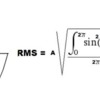JohnGaltLine posted:...
On the .707 vs. .637 subject, I've seen both numbers used for the same thing. I prefer .707 for a couple reasons. There seems not to be any debate over using 1.414 to convert the RMS voltage of a sinusoidal wave to its peak to peak voltage. At least I can't recall any other other number but the square root of 2 being used anywhere. As such, it makes more sense to me to use the reciprocal of SqRt 2 (1.4141) when reversing the calculation. That is .707 times peak equals RMS of the sine wave.
.
What junior researched and posted earlier is correct. Just as there is an exact calculation for the average DC voltage, there's a separate but also an exact calculation for the RMS voltage. By definition RMS is the square-root of the mean squared voltage. So you take the sine wave, square it, integrate it over one cycle (2 pi radians), take the mean (by dividing by 2 pi), then take the square root. A miracle occurs and it all washes out to the square-root of 1/2 (0.707) times the peak value of the sine wave A.
I want to leave no doubt in any OGR reader (not that any are actually slogging through these math bogs...) that average voltage and RMS voltage are two precisely defined but separate values. The relevance of each depends on the application...for example incandescent bulb brightness or smoke heater power are indeed governed by RMS voltage.
In my opinion it is sloppy to use 0.637 and 0.707 interchangeably but to each his own. I prefer the correct number used for the correct purpose.






